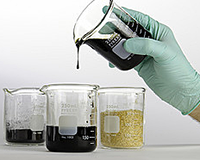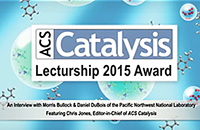
Where There Is Waste, There Is Energy—and Opportunity
By John Holladay, Lynne Roeder, and Bob Weber
Today's low energy prices feed both a false sense of security about U.S. energy availability and a continued appetite for carbon-based fuel and chemical sources. But as history shows, energy prices and oil imports will rise again, swinging the pendulum back toward concerns over energy security and domestic fuel alternatives.
At the same time, the U.S. has an inventory of largely abandoned carbon with an aggregate energy content equivalent to the amount of petroleum we import. These resources, which include low-energy-density wet waste and sludge; forest residue; agricultural, industrial and municipal waste; COX; and flare gas—are geographically dispersed and chemically diverse.
Small, tailored mini-refineries could take advantage of these abandoned resources, significantly change how we use carbon, and reduce environmental impacts. The small scale enables communities to couple low-value carbon resources with seasonal energy demands and other constraints with no offsite shipping of waste. Converting these unused resources may produce kerosene or chemical feed precursors depending on local communities' needs. Read more.
IIC Scientist Exemplifies the Three Ds of Research

Catalysis breakthroughs rely on the three Ds: discovery, development, and deployment. Discoveries such as how to break the chemical bonds in feedstocks to remove sulfur. Developments such as turning fermentation liquids into fuels and chemicals. And deployment, when the combined efforts of discovery and development result in a usable product or method, such as replacing petroleum-based coatings and polymers with ones derived from biomass.
Institute for Integrated Catalysis (IIC) associate director John Holladay added another D to the mix in May when he was named a Battelle Distinguished Inventor at Pacific Northwest National Laboratory. This title is given to staff having 14 or more U.S. patents to their credit as a direct result of their work for Battelle, which operates PNNL for the U.S. Department of Energy.
Holladay, who oversees PNNL's research portfolio on biofuels, products, and energy, has earned 17 patents in the area of catalysis and chemistry related to bio-based processing. These technologies have been licensed to at least eight companies, demonstrating their practical value. Read more.
The Story Behind ACS Winners Dan DuBois, Morris Bullock, and the Hydrogen Catalysis Team
Video interview with Chris Jones, Editor-in-Chief of ACS Catalysis, shows what it takes to control protons
 This issue's video focuses on the work of the award-winning Hydrogen Catalysis Team at Pacific Northwest National Laboratory. They received the 2015 ACS Catalysis Lectureship for the Advancement of Catalytic Science. Morris Bullock and Dan DuBois are interviewed by Chris Jones, Editor-in-Chief of ACS Catalysis, giving the back-story about their research that has revolutionized understanding of the role of proton movement in the electrocatalytic interconversion of electricity and hydrogen fuel. This work has had a profound impact on catalysis as a whole. Watch the video for the whole story, or choose the following segments:
This issue's video focuses on the work of the award-winning Hydrogen Catalysis Team at Pacific Northwest National Laboratory. They received the 2015 ACS Catalysis Lectureship for the Advancement of Catalytic Science. Morris Bullock and Dan DuBois are interviewed by Chris Jones, Editor-in-Chief of ACS Catalysis, giving the back-story about their research that has revolutionized understanding of the role of proton movement in the electrocatalytic interconversion of electricity and hydrogen fuel. This work has had a profound impact on catalysis as a whole. Watch the video for the whole story, or choose the following segments:
0:58 – 3:11 Dan's description of the originating work.
3:24 – 4:22 Morris's description of functional models.
4:41 – 7:30 Dan's description of metal catalyst design.
7:23 – 8:44 The benefits of team-based science.
8:46–10:13 Opportunities at a National Lab.
December 2015
Catalysis News & Research:
Please Do Spill the Oxygen. For the first time, scientists clearly saw oxygen spillover, a phenomenon of interest to catalyst designers. Read more.
Chuck Peden Honored for Vehicle Emission Control Catalysis Research. Dr. Charles H.F. (Chuck) Peden, Pacific Northwest National Laboratory, received the Distinguished Achievement Award from the U.S. Department of Energy's Vehicle Technologies Program, part of the DOE's Office of Energy Efficiency and Renewable Energy. Read more.
Scientists Discover Precise Location of Active Sites on Popular Catalyst. For the first time, researchers saw the active sites on a well-known vanadium-based catalyst. The results could help design of faster, more stable, and cheaper catalysts. Read more.
Aluminum Clusters Shut Down Molecular Fuel Factory. Despite decades of industrial use, the exact chemical transformations occurring within zeolites, a common material used in the conversion of oil to gasoline, remain poorly understood. Now scientists have found a way to locate—with atomic precision—spots within the material where chemical reactions take place, and how these spots shut down. Read more.
Kneading Enzyme Makes Ammonia Levels Rise. Scientists discovered that a small iron-based protein and larger MoFe enzyme roll across each other, likely pushing at the MoFe surface to deliver electrons needed for ammonia synthesis without added hydrogen. The finding is changing ideas about fertilizer production. Read more.
If you have feedback – ideas, suggestions or questions – about IIC's Transformations, please contact Julie Wiley.